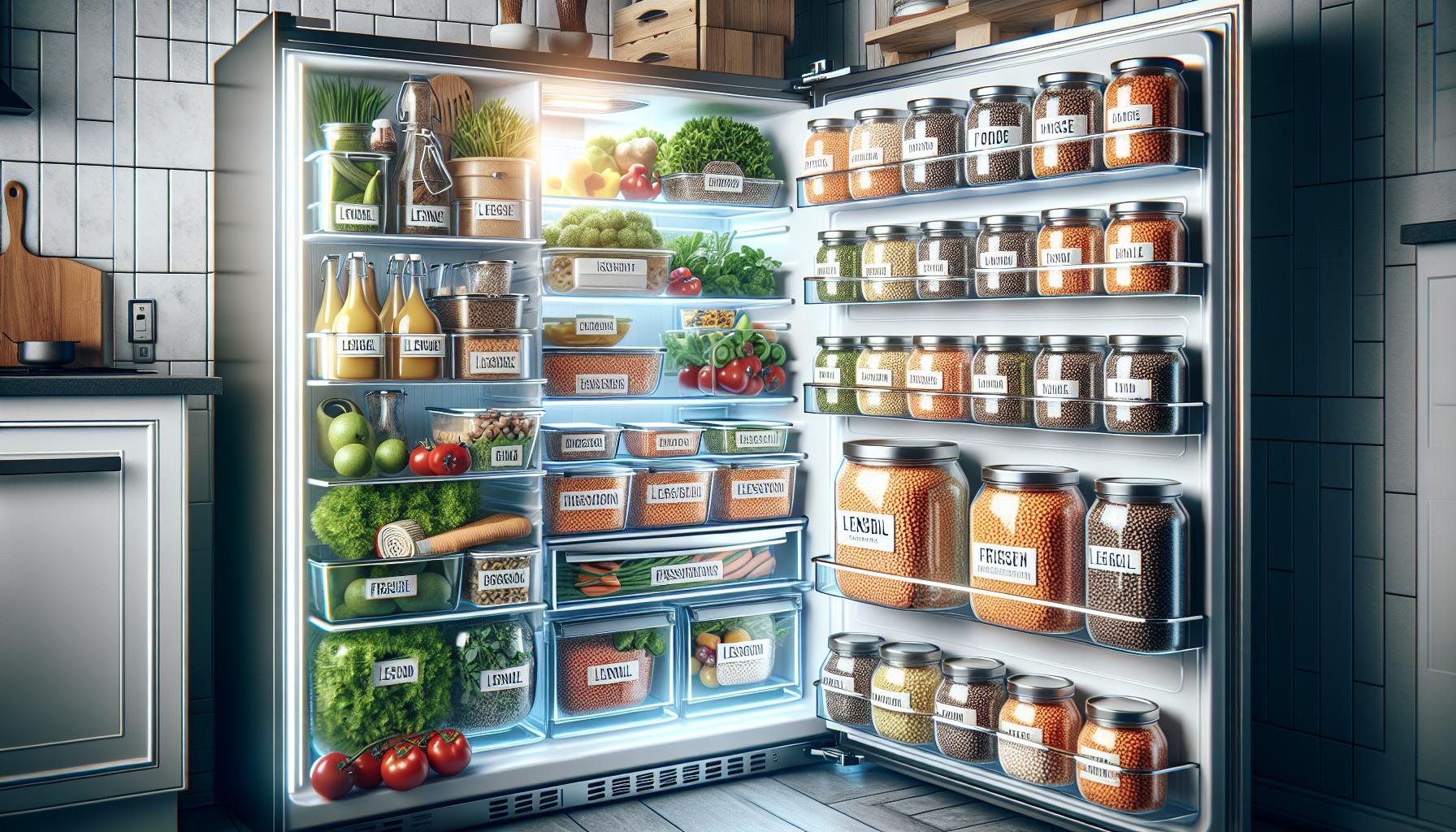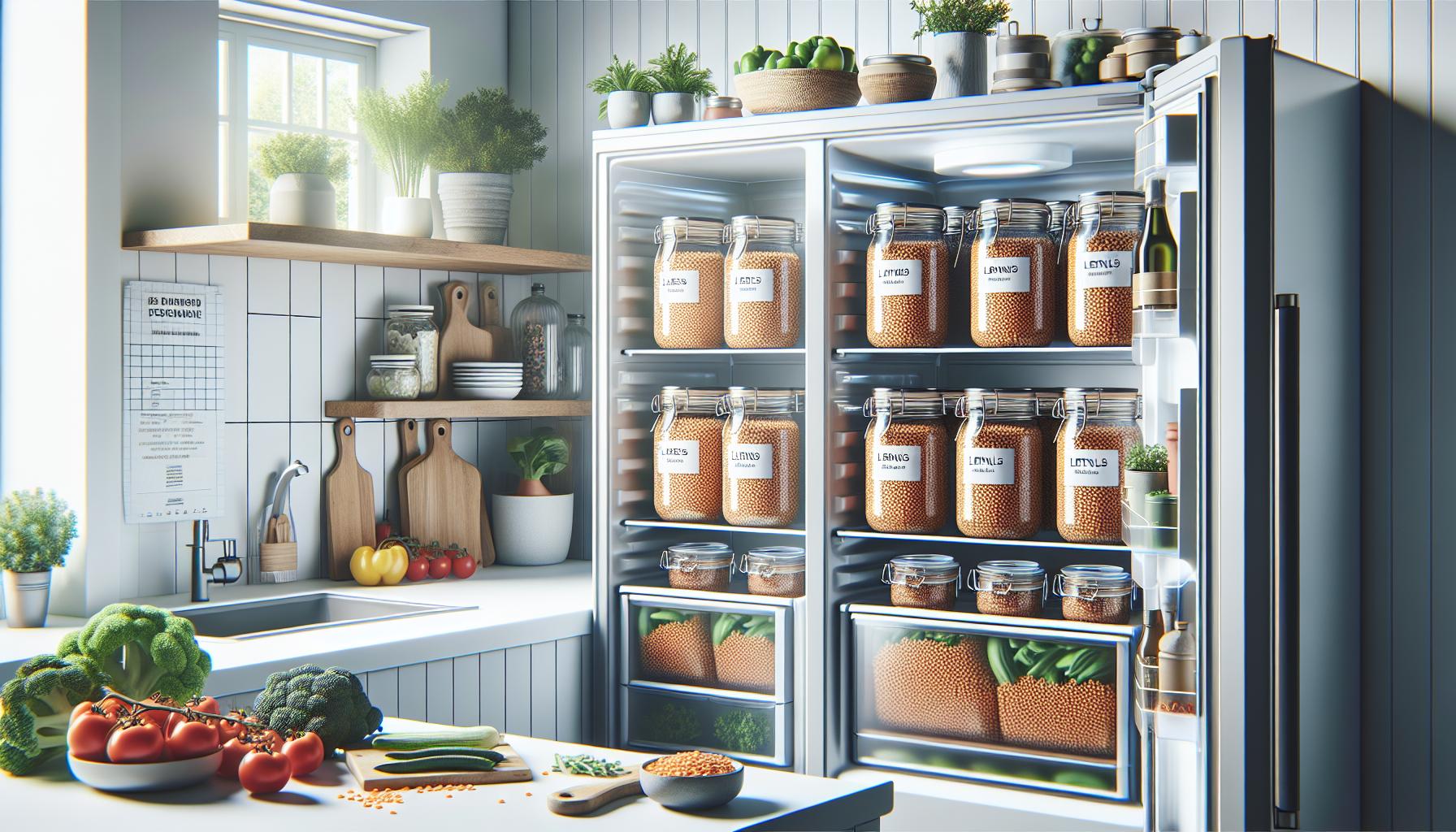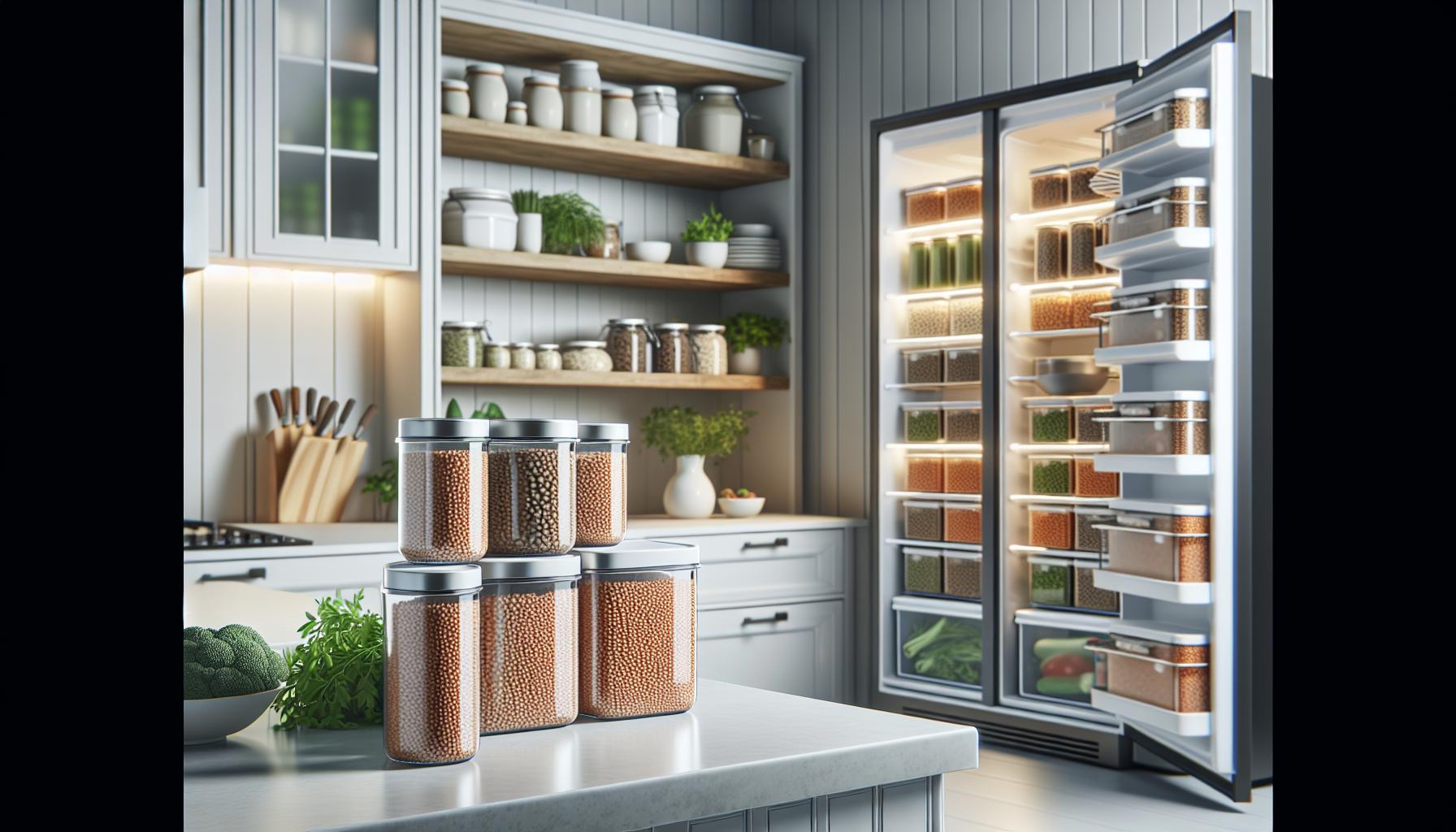Did you know that lentils are packed with essential nutrients, including protein and fiber, making them a staple in healthy diets? However, improper storage can lead to waste and diminished nutrition. Knowing how long lentils last in the fridge is crucial for maintaining their flavor and health benefits.
If you’ve ever wondered about the shelf life of your cooked lentils or how to store leftovers to maximize freshness, you’re not alone. Many home cooks face the challenge of keeping their ingredients both nutritious and tasty. In this article, we’ll explore practical guidelines for storing lentils, ensuring you enjoy their hearty goodness for as long as possible. By understanding the best practices for storage, you can confidently enhance your meals while minimizing food waste.
Lentil Storage: Understanding Fridge Lifespan

Lentils, a staple in many kitchens due to their versatility and nutritional value, can be a mystery when it comes to storage-especially in the fridge. Understanding how long they last stored in various forms is crucial for maintaining their quality and ensuring food safety. Generally, uncooked lentils can be stored in a cool, dry place indefinitely, but once cooked, their lifespan changes significantly.
When lentils are cooked, they can typically last in the refrigerator for about 5 to 7 days when stored properly in an airtight container. It’s essential to allow them to cool completely before sealing them in a container to prevent condensation, which can lead to spoilage. Be sure to label the container with the date they were cooked, so you can keep track of their freshness.
If you’re unsure about their condition or how long they’ve been in the fridge, always trust your senses. Look for signs such as a foul odor, discoloration, or mold. Any of these indicators suggests that they have gone bad and should be discarded. Proper storage and regular checks will help keep your lentils fresh and nutritious, allowing you to enjoy their health benefits without compromising safety.
In summary, knowing how to store and monitor the lifespan of your lentils will not only save you money but also help you maintain a healthier kitchen environment. Whether you’re tossing them into soups, salads, or main dishes, freshness is key to making the most of this nutritious legume.
Signs Lentils Have Gone Bad
If you’ve ever opened your fridge only to encounter an unpleasant smell or an unappealing sight, you know how crucial it is to recognize the signs of spoiled food, especially when it comes to lentils. Understanding these indicators can ensure you maintain a safe kitchen environment and enjoy your meals without worry.
A key sign that cooked lentils have gone bad is a foul odor. Fresh lentils should exhibit a mild, earthy scent; however, if they develop a sour or rancid smell, it’s a strong indication that they are no longer fit for consumption. Additionally, pay attention to the appearance: if you notice any discoloration, particularly a grayish or off-color hue, this could signify spoilage. Mold is another clear warning sign-if you spot any fuzz or unusual patches on the lentils, discard them immediately.
Texture changes can also reveal the state of your lentils. Freshly cooked lentils should be tender but not mushy. If they become excessively soft, slimy, or have a strange texture, this is another reason to be cautious and consider discarding them. You should also be wary of any separation of liquid in the storage container, as this can suggest bacterial growth.
To keep your lentils safe and palatable, always perform a sensory check before use. Consistent monitoring and adhering to the recommended storage timeframe-typically around 5 to 7 days in the refrigerator-will help you avoid any unpleasant surprises and ensure that your lentils remain a nutritious component of your meals. By being vigilant about these signs, you’re not just preserving the quality of your food; you’re also safeguarding your health.
Optimal Storage Conditions for Lentils

To maximize the freshness and longevity of lentils in your fridge, it’s essential to create the right storage conditions. Lentils thrive when kept in a cool, dry environment, as exposure to moisture can lead to spoilage. Ideally, uncooked lentils should be stored in an airtight container to limit air exposure and humidity. A dark cupboard or a pantry can serve as an excellent storage location, away from direct sunlight and heat sources.
Once cooked, lentils should be transferred to a clean, dry container with a tight-fitting lid. This minimizes air exposure and helps to prevent bacteria growth. Always allow your lentils to cool to room temperature before sealing them to avoid condensation, which can foster an environment suitable for spoilage. Placing the container in the fridge promptly will keep your lentils safe; they generally remain good for 5 to 7 days when properly stored.
Maintaining a consistent temperature in your refrigerator also plays a critical role in preserving the quality of stored lentils. The ideal fridge temperature is at or below 40°F (4°C). Use a refrigerator thermometer to verify that your appliance maintains this temperature consistently. If you plan to keep cooked lentils for longer, consider refrigeration as a temporary measure until you can proceed with freezing, which can extend their life significantly.
Ultimately, being mindful of these optimal storage conditions will not only keep your lentils fresh and tasty but also ensure that they retain their nutritional integrity. With proper care, you can enjoy the rich flavors and health benefits of lentils without the worries of spoilage.
How to Store Cooked Lentils for Freshness

To ensure that your cooked lentils remain fresh and safe to eat, understanding the best storage practices is essential. Cooked lentils, when handled correctly, can stay delicious and nutritious for up to 5 to 7 days in the refrigerator. The key lies in minimizing exposure to air and preventing moisture buildup, which can accelerate spoilage.
Begin by transferring your cooked lentils into a clean, airtight container as soon as they have cooled to room temperature. This type of container not only protects the lentils from air but also helps to keep out any bacteria that might cause spoilage. Always allow the lentils to cool before sealing the container; sealing them while still warm can create condensation inside, fostering an environment conducive to mold.
Once stored, place the container in the fridge, ensuring your refrigerator is set to 40°F (4°C) or lower. It’s advisable to check the temperature with a fridge thermometer to maintain consistent conditions. If you find yourself with an abundance of cooked lentils that you can’t consume within a week, consider freezing them. Frozen cooked lentils can last up to six months and retain their nutritional value. When you’re ready to use them, simply thaw in the refrigerator overnight or heat directly from frozen.
To further enhance the longevity of your cooked lentils, be mindful of how you reheat them. Ensure they reach an internal temperature of at least 165°F (74°C) before serving. This practice not only enhances flavor but also ensures that any potential bacteria are killed. By adhering to these guidelines, you can enjoy the health benefits of lentils while reducing food waste.
Tips to Keep Lentils Nutritional Value Intact

To maximize the nutritional value of lentils while storing them in the fridge, it’s essential to implement best practices that maintain their integrity. Lentils are packed with protein, fiber, and various vitamins and minerals, but their exposure to improper storage conditions or prolonged shelf life can diminish these benefits.
One effective way to preserve the nutrients in cooked lentils is to minimize their exposure to air and moisture. When transferring lentils into storage, select a clean, airtight container. This prevents oxygen infiltration, which can lead to nutrient degradation and spoilage. If you find yourself cooking a large batch, consider dividing them into smaller portions before sealing them in individual containers. This approach not only reduces the time lentils remain open to air when accessing your supply but also maintains their freshness by avoiding repeated exposure.
Additionally, keeping lentils cold is crucial. Your refrigerator should maintain a temperature of 40°F (4°C) or lower. This temperature slows down spoilage processes and retains the vitamins and minerals essential for health. Regularly check your refrigerator’s temperature with a thermometer to ensure it remains consistent. If the lentils were originally steamed or boiled, factors like cooking time and seasoning can impact nutrient retention. For instance, overcooking can lead to the breakdown of certain water-soluble vitamins, so aim for a cooking time that achieves tenderness without compromising nutrition.
- Limit Light Exposure: Store lentils in a dark environment as light can degrade some nutrients. Using opaque storage containers or placing them in a cupboard can help.
- Consider Freezing: If not consumed within a week, freezing lentils can be an excellent option. They can maintain their nutritional value for up to six months in the freezer. Just make sure to cool them completely before transferring them to freezer-safe bags, expelling any air before sealing.
- Reheat Properly: When it’s time to enjoy your lentils, reheat them to an internal temperature of at least 165°F (74°C) to enhance their flavor and eliminate any harmful bacteria.
By adhering to these storage tips, you can ensure that your lentils not only remain fresh but also retain their nutritious properties, allowing you to enjoy their health benefits for longer. Savoring fresh lentils regularly can contribute significantly to a balanced diet rich in essential nutrients.
Freezing Lentils: A Comprehensive Guide
Freezing lentils can be a game-changer for anyone looking to extend the shelf life of this nutritious food while retaining its flavor and health benefits. When properly frozen, lentils can last up to six months, ensuring you have a healthy ingredient ready at your fingertips for soups, salads, or side dishes. To achieve the best texture and nutritional quality, follow these straightforward steps to freeze your lentils effectively.
Start by preparing your lentils. If they are uncooked, rinse them under cold water to remove any debris or dust. Cooked lentils should be cooled completely before freezing. To ensure they freeze evenly and maintain their flavor, spread them out on a baking sheet in a single layer and place them in the freezer for a few hours. Once frozen, transfer the lentils to airtight freezer-safe bags or containers. Remove as much air as possible to prevent freezer burn, which can negatively affect texture and taste. Label the bags with the date to keep track of their shelf life.
Thawing and Using Frozen Lentils
When it comes time to use your frozen lentils, you have several options for thawing. The safest method is to transfer them to the refrigerator and let them thaw overnight. For quicker options, you can thaw them in the microwave or add them directly to soups or stews without thawing. Note that the texture of previously frozen lentils may be slightly softer than fresh, so consider using them in recipes where this is acceptable.
Additionally, always ensure that the lentils are reheated to a safe internal temperature of at least 165°F (74°C) if they were fully cooked before freezing. This not only enhances flavor but also eliminates any potential food safety concerns.
By freezing lentils, you not only reduce food waste but also maintain a versatile ingredient that can enhance a variety of dishes while keeping meal prep convenient and nutritious. Enjoy the benefits of having this powerhouse of protein and fiber readily available in your kitchen!
Creative Ways to Use Leftover Lentils
Leftover lentils are a culinary treasure, packed with protein and versatility, ready to transform unremarkable meals into nutritious delights. With the right creativity and a dash of inspiration, you can turn your surplus into various dishes that are not only delicious but also easy to prepare.
One of the simplest and most satisfying uses for leftover lentils is to incorporate them into salads. Toss them with fresh greens, chopped vegetables, nuts, and a zesty vinaigrette for a hearty and nutrient-dense meal. Lentils pair beautifully with ingredients like feta cheese, olives, or roasted peppers, creating a Mediterranean flair that breathes life into your lunch. Another popular option is to make lentil burgers. Mash the lentils and mix with breadcrumbs, spices, and your choice of sauces, then pan-fry or bake for a satisfying vegetarian patty that can hold its own on any grill.
In addition to being a fantastic ingredient for salads and burgers, leftover lentils can be stirred into soups and stews for added texture and nutrition. Simply add them to your favorite broth alongside vegetables, grains, or even small pasta. Not only will this amplify the flavor, but it will also enhance the meal’s protein content, making it more filling and nourishing. For a creative twist, consider using lentils as a base for a savory breakfast bowl. Combine them with sautéed greens, a poached egg, and a sprinkle of chili flakes or hot sauce for a nutrient-rich start to your day.
Lastly, don’t overlook the power of lentils in baked goods. Incorporating pureed lentils into recipes for muffins or pancakes can boost the fiber content while lending moisture to the final product. This not only minimizes waste but also elevates the nutritional profile of your treats, making them guilt-free indulgences.
By repurposing leftover lentils in these inventive ways, you not only reduce food waste but also enjoy diverse, healthful meals. Remember to keep any leftover lentils stored in airtight containers in the refrigerator, where they’ll stay fresh for up to a week. Whether creating a vibrant salad, a comforting soup, or a clever breakfast option, your leftover lentils can shine brightly in the kitchen.
Benefits of Eating Fresh Lentils Regularly
Eating fresh lentils regularly can greatly enhance your diet, combining nutrition with versatility. These small legumes are a powerhouse of essential nutrients, including protein, fiber, vitamins, and minerals. They are particularly rich in folate and iron, making them an excellent choice for those looking to improve their overall health. Consuming lentils frequently can help support your immune system, promote heart health, and even assist in weight management, as their high fiber content aids in feeling full and satisfied.
Fresh lentils can be easily incorporated into a variety of dishes, not only increasing the nutritional value but also introducing diverse flavors and textures. For example, adding them to salads, soups, and stews can transform simple meals into satisfying and hearty options without significantly increasing calories. Furthermore, their ability to adapt to various seasonings and cooking methods-from being spiced with curry in a stew to serving as a base for a fresh Mediterranean salad-means that they can seamlessly fit into any diet or cuisine.
The benefits of fresh lentils extend beyond just their nutritional profile; they are also a sustainable food choice. Lentils require less water to grow compared to many other crops, making them an environmentally friendly option. By incorporating fresh lentils into your meals, you are not only investing in your health but also supporting sustainable agricultural practices.
Incorporating fresh lentils into your daily meals can lead to long-lasting health benefits. Whether you choose to make a simple lentil salad, a flavorful soup, or even veggie burgers, the possibilities are endless. To reap the highest benefits, aim to consume fresh lentils within a week of cooking them, as this maximizes their nutritional value and ensures that you enjoy their delightful texture and taste.
Common Mistakes in Lentil Storage
Storing lentils improperly can lead to a significant loss in quality and nutritional value. One of the most common mistakes is neglecting to store dried lentils in a cool, dark place. Exposing them to heat, light, or moisture can lead to spoilage or the invasion of pests. Dried lentils should ideally be kept in an airtight container, stored in a pantry or cupboard, away from direct sunlight. Always remember that lentils do not have a long shelf life once opened-aim to use them within 1 to 2 years for the best quality.
Another frequent error is failing to properly cool cooked lentils before refrigerating. Placing warm lentils directly in the fridge can raise the internal temperature, putting other foods at risk of bacterial growth. To avoid this, let the lentils cool down to room temperature for no more than two hours before transferring them to the refrigerator. Once stored, they’re best consumed within 3 to 5 days, but be sure to check for signs of spoilage, such as off-smells or changes in texture.
Moreover, many people overlook the importance of labeling stored lentils. Whether dried or cooked, labeling containers with the date allows for easy tracking and ensures you’re using them while still fresh. In the case of cooked lentils, using them within a week is crucial for maintaining not just flavor, but also their nutritional benefits. For those who might not be able to consume them quickly, freezing cooked lentils can be a game-changer; just ensure they’re in airtight containers or freezer bags to prevent freezer burn.
Finally, a common misconception is that expired lentils are automatically unsafe to eat. While an expiration date is a guideline, dried lentils can often remain safe and flavorful beyond that date if stored correctly. However, it’s essential to conduct a sensory check-look for mold, off odors, or unusual colors before use. By paying attention to these details in storage, you can maximize both the longevity and enjoyment of your lentils.
Are Expired Lentils Safe to Eat?
Expired lentils can often still be safe to eat, but caution is advised. Unlike perishable foods, dried lentils last considerably longer past their expiration date if stored correctly. While an expiration date serves as a guideline for peak quality, there are several factors that determine whether your lentils remain safe for consumption.
Before using lentils that have surpassed their expiration date, conduct a sensory examination. Look for any signs of spoilage, such as:
- Unusual odors: Fresh lentils have a mild, earthy scent. If they smell off or musty, it’s best to discard them.
- Visual check: Inspect for mold, discoloration, or the presence of pests. If any of these are noted, the lentils should not be consumed.
- Texture: Fresh lentils should be hard and firm. If they feel excessively soft or powdery, they may have gone bad.
Even if they appear okay, keep in mind that the nutritional value of lentils may degrade over time, especially after long storage periods. Nutrients like proteins, vitamins, and essential minerals may lessen, diminishing the health benefits they provide.
If the lentils pass the examination but are a bit stale, you can rejuvenate them by cooking them in flavorful broths or adding them to various dishes, which will help mask any slight decline in taste. If you’re unsure and the lentils were stored under poor conditions or for an extended time, it’s better to err on the side of caution and discard them.
In summary, expired lentils can be safe to eat if they show no signs of spoilage, but always prioritize food safety and quality in your kitchen practices.
Best Practices for Meal Prepping with Lentils
Lentils are a fantastic staple for meal prepping, offering a great source of protein and fiber while being versatile and easy to cook. When meal prepping with lentils, it’s essential to adopt best practices to ensure they remain fresh, nutritious, and ready to enhance your meals throughout the week. The key lies in proper storage, cooking techniques, and usage.
Storage Tips for Prepared Lentils
Once cooked, lentils can be stored in the fridge for about 5 to 7 days. To preserve their freshness, transfer them to an airtight container as soon as they cool down. This prevents moisture loss and protects them from contaminants. Adding a splash of olive oil can also help maintain their texture and flavor. Always label containers with the date of preparation to keep track of their freshness.
Freezing for Longevity
If you have leftover cooked lentils that you won’t use within a week, freezing is a perfect option. Portion the lentils into freezer-safe bags or containers, removing as much air as possible to prevent freezer burn. Cooked lentils can last in the freezer for up to 6 months. To use them, simply thaw in the fridge overnight or reheat directly from frozen in soups or stews.
Creative Integration in Meals
Incorporating lentils into your meals is easy with a little creativity. Add them to salads for added protein, use them in soups and stews, or blend them into veggie burgers for a nutritious twist. You can also mix cooked lentils into grain bowls or falafel for a hearty meal. Mixing cooked lentils with spices and sautéed vegetables creates a delicious filling for wraps or tacos.
Lastly, always taste and check the texture of your lentils before incorporating them into meals. Freshly cooked and stored lentils should have a pleasant flavor and firm-but-tender texture. By using these best practices, you’ll ensure your meal prep is efficient, healthy, and delicious!
Health Benefits of Incorporating Lentils in Your Diet
Incorporating lentils into your diet can be a powerful step towards enhancing your overall health. Packed with protein, fiber, and essential vitamins, these tiny legumes offer a wealth of nutritional benefits that can significantly improve your well-being. For instance, just one cup of cooked lentils provides about 18 grams of protein and 16 grams of dietary fiber, which can contribute to improved digestive health and help maintain steady blood sugar levels. This makes lentils an excellent choice for individuals seeking plant-based sources of protein or looking to manage their weight effectively.
Nutritional Highlights
Lentils are also rich in various essential nutrients, including iron, magnesium, and B vitamins, which play crucial roles in maintaining energy levels and supporting metabolic health. The high iron content is particularly beneficial for those at risk of anemia, as it aids in the production of hemoglobin. Furthermore, the fiber in lentils not only promotes regular bowel movements but also helps lower cholesterol levels, reducing the risk of heart disease. Including lentils in your meals can provide a heart-healthy boost while also being low in fat.
Supporting a Healthy Diet
An easy way to reap the health benefits of lentils is by adding them to your weekly meal prep. Whether you toss them in salads, incorporate them into soups, or blend them into dips, lentils offer versatility and can be a satisfying addition to a variety of dishes. This adaptability ensures that you can enjoy their flavor while maximizing nutritional intake. Additionally, their long shelf life-particularly when stored properly in the fridge for up to a week or frozen for several months-means that you always have a healthy option on hand.
By embracing lentils in your diet, you not only enhance your nutrition but also support sustainable eating habits. As a whole food, lentils require minimal processing and provide a nourishing option that aligns with dietary guidelines focused on plant-based foods. So, the next time you prepare meals, consider incorporating these nutrient-dense legumes to boost both health and flavor.
Frequently asked questions
Q: How can I tell if lentils are still good to eat?
A: To check if lentils are still good, look for signs such as an off smell, discoloration, or the presence of mold. If cooked, inspect for an unusual texture or sour taste. Properly stored cooked lentils typically last 3-5 days in the fridge.
Q: What is the best way to reheat lentils?
A: The best way to reheat lentils is to do so on the stove or in the microwave. Add a splash of water or broth to prevent drying out and heat until fully warmed, stirring occasionally. This maintains their texture and flavor.
Q: Can I eat lentils that have been in the fridge for more than a week?
A: It’s not recommended to consume lentils stored in the fridge for over a week, as they may harbor bacteria that can cause foodborne illness. Always adhere to the 3-5 day guideline for cooked lentils to ensure safety.
Q: How do you store lentils to maximize their shelf life?
A: To maximize shelf life, store dried lentils in an airtight container in a cool, dark, and dry place. Cooked lentils should be refrigerated in a sealed container and consumed within 3-5 days to prevent spoilage.
Q: Are frozen lentils safe to eat after a year?
A: While frozen lentils can remain safe to eat after a year, their quality may degrade. For best taste and texture, consume them within 6 months. Always check for ice crystals or freezer burn before use.
Q: What nutrients do lentils provide when cooked?
A: When cooked, lentils are an excellent source of protein, fiber, iron, and folate. They also provide essential amino acids and are low in fat, making them a nutritious addition to any diet.
Q: Why should I include lentils in my diet?
A: Including lentils in your diet offers numerous health benefits, such as improved digestion due to high fiber content, enhanced heart health, and support for weight management. Their nutritional profile makes them an excellent choice for balanced meals.
Q: Can lentils be reused in meal prep after being cooked?
A: Yes, cooked lentils can be reused in meal prep. Make sure to store them in a proper container in the fridge and consume them within 3-5 days. They can be added to soups, salads, or blended into dips for versatile meals.
Future Outlook
Now that you’re equipped with the knowledge of how long lentils last in the fridge, you can confidently store them while retaining their nutritional benefits. Remember, keeping your lentils fresh not only contributes to better meal preparation but also reduces food waste. For seamless meal planning, check out our guidelines on storage techniques or explore delectable healthy soup recipes, like the Tomato and Lentil Soup or Vegetable Lentil Stew, that can help you make the most of your lentils.
Don’t hesitate to bookmark this article for future reference, and feel free to dive into our extensive collection of healthy recipes that include legumes in delightful ways. Share your thoughts or your favorite lentil recipes in the comments below, and subscribe to our newsletter for more practical tips and mouthwatering ideas sent straight to your inbox. Keep your kitchen vibrant and your meals enjoyable, and remember-freshness is just a fridge away!





